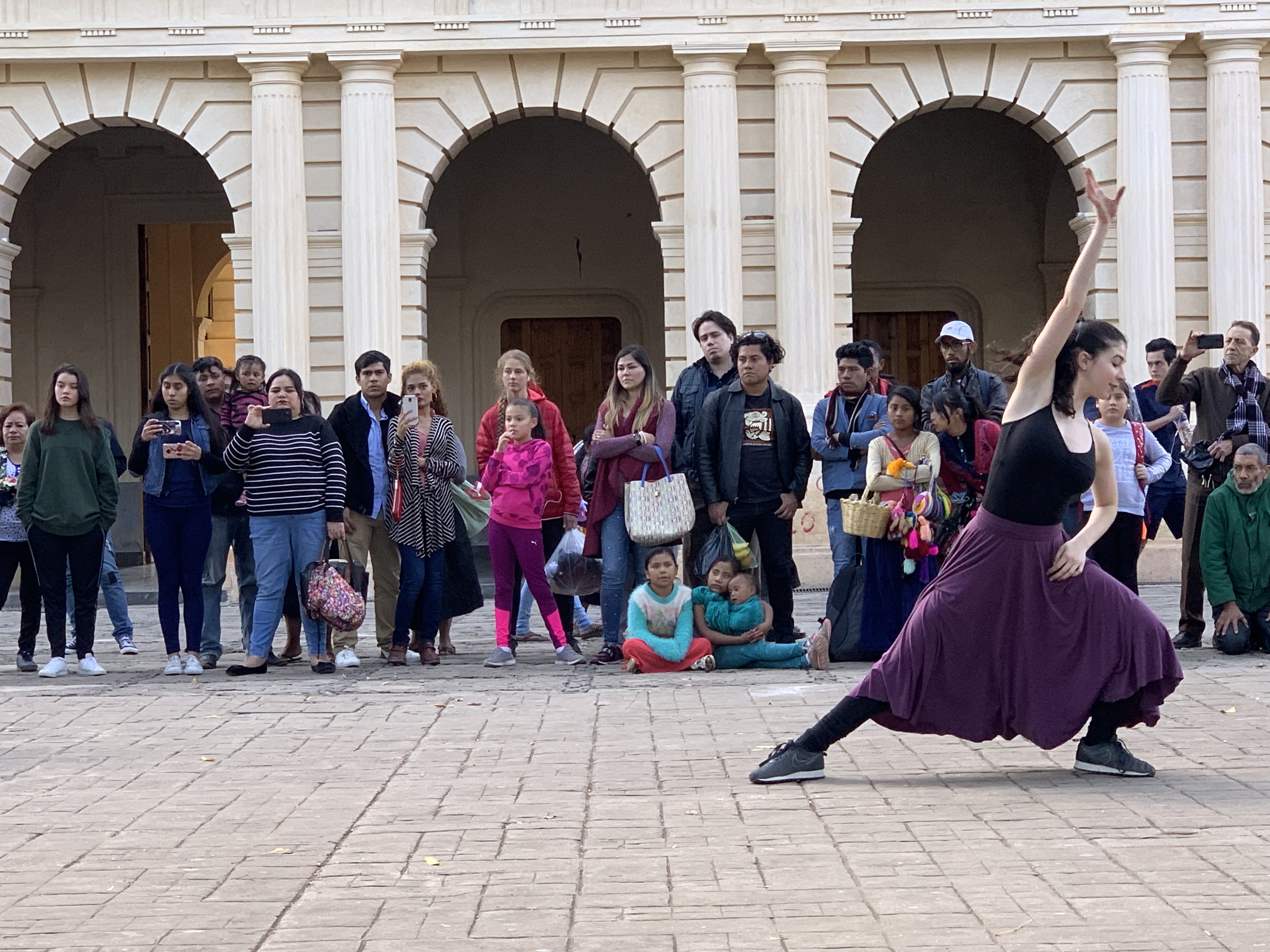Photo of Avery Casasanta performing Paloma Negra.
This past January, JUNTOS invited past student and choreographer Liv Schaffer to join us in Mexico to reset a work that she had choreographed as a student: Paloma Negra. We are thrilled that she was able to write a guest post about her journey for the blog. Enjoy!
—
Seven years have passed since my last JUNTOSAbroad trip as a student with LINES BFA Program. Attending a trip again, time and dust settled, I felt stunned with a deep well of reflection. I was able to witness my best friend and Abroad Programs Director, Amy McMurchie, lead with humanity and excellence. We went on our first trips together to regions near Oaxaca. I was filled with pride about and for her. I was honored to be included in what she’s done with the organization. I was able to put years worth of my own community arts training and career development to use within the organization that originally inspired this trajectory of my work. I was able to mentor college students, seeing myself in them, having almost visceral flashbacks to my own first, second, and third JUNTOSAbroad trips as a student. I could see that the me from back then had changed a million times over to who I am now. I became curious about who the students we were traveling with could become in their future. I felt ignited. I felt like I was in true flow; doing something I loved surrounded by people I loved. I felt belonging and purpose being asked to be a part of the leadership within an organization I had already invested so much into.
What I had felt drowned in and blinded by as a student on Abroad trips, became organized and clear to me while traveling as a choreographer. The tumultuous tension between privilege, guilt, service, and sharing quieted and made space for more authentic artistic curiosities around what bodily wisdom other cultures, lifestyles, or experiences hold that offer countering perspectives to a Western view of dance. I studied the bodies of people we interacted with, including my own, without hierarchy or judgment. The trip became research along trails of my own inquiries regarding bodies in trauma, aging bodies, and joyful bodies. I was submerged in a trip devoid of time. My memories of JUNTOS from when I was a student, dancing with who I am now. Remembering so much of JUNTOS from the student perspective, yet guiding those around me from my own new role. Tasting new regions of Mexico, yet being reminded of the essence that is the same on every trip: unexpected people coming together to create unexpected things. People being present with each other. People learning. People cultivating sensitivity to one another.
It was when I began working on Paloma that I really started to feel like I was time traveling. I created Paloma for my BFA Thesis, after being on JUNTOS trips as a student. I made it with hopes that it would become a part of the JUNTOS repertoire, envisioning our outreach settings as its home. Its inception was during a time of my life when I was grieving the loss of my father, and I was angry. I felt what seems like now a naive need to let the world know I was angry. I was inspired by the expressiveness of cultures we visited with JUNTOS, the androgynous and resilient attitude of Frida Kahlo, and by the ping pong between numbness and rage that colored my inner terrain on the daily. I needed a place to unhinge, and so I built it. I invited others to unhinge alongside me. I’ve performed the work myself, in the ensemble and the solo iteration, on abroad trips and during local outreach. It has held many lives, many versions, many cast members, many viewers, many memories. It tethered me to the communities we visited with JUNTOS. It allowed me to feel in unison with the pain we encountered within those communities. It reminded me I wasn’t alone in grief. It was an ode to the realities we had seen on our Abroad trips in hospitals, HIV centers, orphanages, and schools. It formulated my choreographic process and aesthetic.

Rehearsal with Liv, Mexico 2019.
With its brand new cast of four women, I reset and recreated Paloma in 12 hours. What an honor it is to revisit something. I witnessed the evolution of my amateur choreographic choices from inaccessible vision to clarity. I giggled at how who I used to be created fertile soil for empowering four new cast members. I dealt with it light-heartedly, I felt like a loving mother being playful with her child. I’m no longer angry in the way I was in 2013. I invited the cast to unhinge like I was anyway. I encouraged them to lean into the unknown that awaits them when they remove restrictions and fear. I gave the work to them, as if unhinging was a necessary part to growing as a dancer and as a human. I made and remade the work with histories I’ll never know flittering somewhere in our collective memory; people who helped me make it in 2013, people who have performed it, audiences who have seen it, ghosts of cultures past that shaped its music and aesthetic. Revisiting Paloma let my past grief look at my current grief, and finally crack a smile of acceptance. It was a joyous moment of closure for me. I dipped back to a younger version of myself, and was able to bring some of her back to life again.
I was reminded, as I often am on JUNTOS trips, that we practice sharing our work with others not because we get something from it, like an opportunity or award, and not because we validate personal sacrifice for community engagement as honorable or humble. We practice sharing our work with others, inviting others to our work, because we are capable of hybridizing high artistic rigor and democratic action. Today’s artists don’t need to be dictators at the front of the room to produce high quality art, and they don’t need to succumb to a lower standard of community-based work in order to give fulfillment to non-competitive roots of dancing bodies. By expanding the gait of our artistic endeavors to cross barriers and include a collaboration of cultures, we are able to be ambassadors for the dissolution of those borders on a cultural and political level. JUNTOS gives life to this intersection of art and social action, and most importantly has appointed ferocious leaders, students, and community participants to perpetuate the mission, collaboration, and empowerment, long after a trip is over.
Big thanks to JUNTOS for the opportunity to return as a choreographer, and much love to the student volunteers on the Mexico 2019 trip! It was my pleasure to be a part of your work, and I can’t wait to see how you each continue in greatness.

